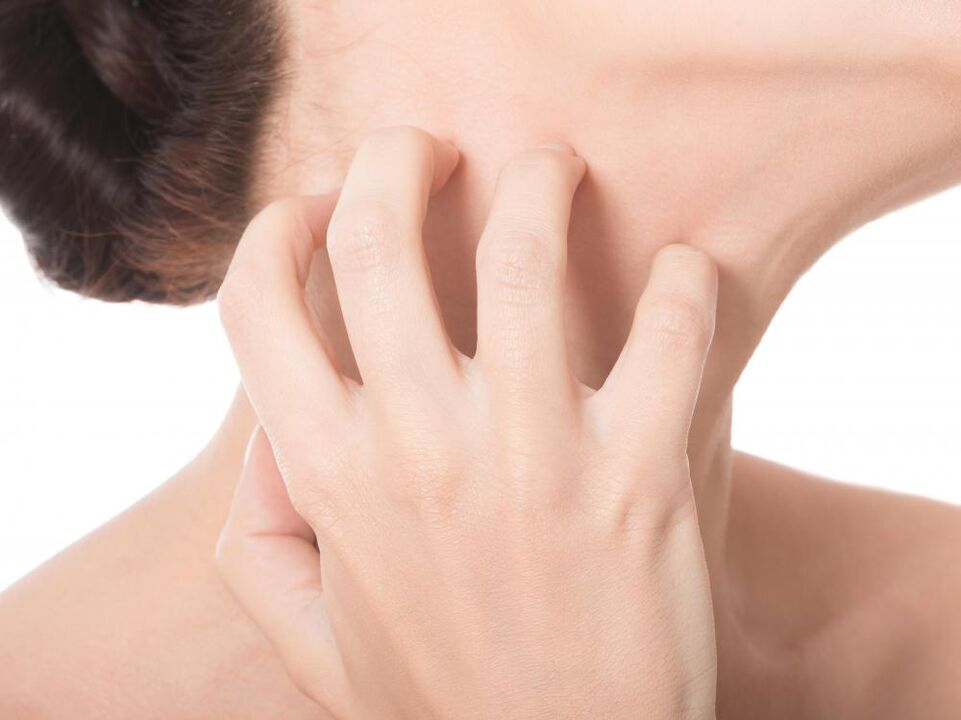
The causes of skin lesions with psoriatic plaques have not been fully determined. The vast majority of doctors believe that genetic predisposition is the main factor in the development of pathology. Psoriasis is a systemic, non-infectious, chronic, recurrent disease that mainly affects the skin, nails and joints.
Main signs and causes of psoriasis
Psoriatic disease is characterized by increased reproduction of epidermal cells. Normally, cell division, maturation and death occur within 3-4 weeks. In psoriasis, this process does not last more than 5 days.
Externally, this is manifested by the formation of dense areas of red or pink color on the skin, covered with small white scales of dead cells. If carefully scraped, a thin shiny film (termina) with a clearly visible network of capillaries will be revealed. After a slight friction, drops of blood appear on it.
This characteristic is called the "psoriatic triad" and is the main difference between psoriasis and other skin diseases. To confirm the diagnosis, a histological examination of skin particles from the affected areas is performed.
The main factors that cause psoriasis are:
- Exogenous (external causes). This includes various skin injuries of a physical or chemical nature.
- Endogenous (internal causes). They can consist in the presence of diseases of the immune system, endocrine system, HIV infection. Smoking, alcohol, unhealthy diet also cause psoriatic skin lesions.
- Psychogenic. In most cases, the first manifestations of psoriasis appear after suffering nervous shocks or long-term emotional overstrain.
Skin rashes are often the result of infectious and inflammatory diseases. Many doctors attribute this to a weakened immune system. People with a genetic predisposition to psoriasis are advised to avoid factors that provoke it.
Forms of psoriatic disease
This or that form of the disease depends on the type of rash and the place of their localization. During pregnancy, due to changes in the hormonal background, psoriatic manifestations may disappear or, on the contrary, manifest with greater force.
psoriasis vulgaris
The most common form of pathology. The first signs are a papular rash. They can be single, grouped on different parts or all over the body. As the disease progresses, psoriatic plaques increase in size and gradually merge with each other.
Depending on the form of the rash, ordinary psoriasis is divided into:
- punctate (dot-shaped papules the size of a match head);
- in the form of drops (oblong spots the size of a pinhead);
- coin-shaped (pea-sized round plates).
The rash can be in the form of an arc, a circle, a spiral, a wreath. Sometimes they resemble the outlines of continents on a geographical map. If the disease is localized on the scalp, then it is called seborrheic psoriasis. Sometimes the neck, nose, forehead and chest are affected. The diagnosis is difficult due to the similarity of the pathology with seborrhea.
Recognizable characteristics are the clarity of the borders of the affected areas, the presence of the "psoriatic triad", the silvery color of the scales. Itching often occurs, hair does not fall out.
The accumulation of plaques on the feet and hands gave the name palmoplantar psoriasis. It is characterized by the formation of polished areas of the skin, similar to corns. Psoriasis of the nails changes their color, shape and structure. They loosen, are covered with small depressions and take the shape of a thimble.
Isolation of the exudate from the papules causes a burning sensation. The scales stick together and form a crust that adheres tightly to the skin. In this case, they are talking about the exudative form of psoriasis.
In severe cases, the entire surface of the body is affected. The skin becomes hot to the touch, takes on a red hue, swells, there is severe itching, burning and a feeling of tightness. This form of the disease is classified as psoriatic erythroderma.
Pustular psoriasis
It occurs quite rarely. It develops against the background of vulgarity or appears on absolutely healthy skin. In this case, inflamed areas first appear, on which blisters are formed during the day, which quickly turn into pustules. Their contents are sterile and when drained, they dry and form crusts.
There are several types of disease. All of them are characterized by chills, fever, fever, sometimes diarrhea, vomiting. The condition worsens when the pustules coalesce and occupy large areas of the skin. If pustular psoriasis appears on the background of psoriasis vulgaris, then fusion is not observed.
Arthropathic psoriasis
It affects joints, usually small ones (phalanges of fingers and toes). Sometimes the pathological process affects the spine. This form of psoriasis often leads to disability.
The first signs of the disease are pain, aggravated by movement, and swelling in the joints. Evening fever, disorder of the gastrointestinal tract, loss of appetite are characteristic of the worsening of the disease.
Over time, joint deformity and loss of mobility occur. The pathology can develop independently or in parallel with the skin manifestations of psoriasis vulgaris.
All forms of pathology can develop gradually, over years, or quickly, over several days or even hours. The treatment regimen depends on the form and degree of the disease and should be drawn up by a specialist dermatologist.
External means in the form of ointments and gels and physiotherapy are most often prescribed. In some cases, drug therapy is required. Self-medication can lead to worsening of the disease.























